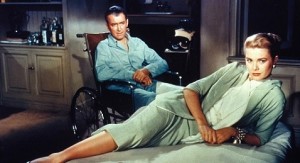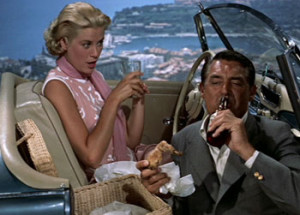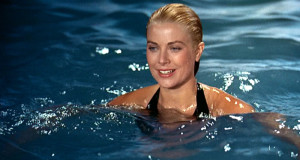By Daniel Garrett.
Some old films have a special appeal. They might not be excellent or particularly beloved objects, and yet they have something that sustains our attention. When I saw Mogambo (1953), I found the love triangle in it interesting even as I recognized its familiarity: an honest rogue – sophisticated, but choosing to live in the rough – meets a sensual woman whom he has fun with, but he becomes infatuated with a visiting lady he begins to take seriously. Clark Gable is the wild man Victor Marswell, Ava Gardner is Eloise Kelly, the direct, laughing, sensuous woman with a wounded heart, and Grace Kelly is Linda Nordley, the too easily tempted proper married lady. Grace Kelly is the wife of an anthropologist, Donald Nordley, who has hired Gable’s Victor as guide to take Donald and his wife on safari to see gorillas.
Kelly and Gardner represent different types of femininity (of course, there are more than two): Kelly appears the ideal but has principles that she easily betrays, whereas Gardner has no illusions and proves to have a more genuine character. It is innocence versus experience. Yet Grace Kelly has very appealing moments – as when she first goes out for a long walk alone and seems curious, light, and free, open to whatever may occur. John Ford’s Mogambo is a 1950s remake of Red Dust (1932), a film set in French Indochina, in which Gable himself had starred as a plantation owner, with Mary Astor as the lady and Jean Harlow as the good time girl. In his October 2, 1953 New York Times review of Mogambo the suddenly warm Bosley Crowther considered the film’s atmosphere lush, and Ava Gardner part of its primary appeal – thinking the attractive, sly Gable little match for Gardner; and though Crowley commended the other actors he seemed to prefer Africa’s natural wonder and its animals.
It would be a cliché to say that Grace Kelly’s was a vision of beauty, charm, and elegance, a woman of bearing, of intelligence and talent, and that her life was like a fairy tale. It would be a cliché and yet it would be true. Grace Kelly had, and has, a wonderful film presence – effervescent, elegant; she is a great pleasure to watch. Grace Kelly was a great American girl, and an impressive young lady; a very memorable woman: Grace was the daughter of two athletes: her father John Brendan Kelly, Senior, an Irish American, won gold medals as a member of a rowing team, and, quite shrewd, went on to make a fortune in the brick business. John Senior, once an army lieutenant, boxer, and a football player, became chair of the Philadelphia County Democratic Party, Fairmount Park Commission president, and President Roosevelt’s National Fitness Director, among other civic posts (he was also said to be the model for the industrious George Kittredge in The Philadelphia Story). Grace Kelly’s mother, Margaret Katherine Majer Kelly, a German swimmer and model, was a respected athlete as well, becoming a coach of women at the University of Pennsylvania, and later Margaret Katherine did work with the Women’s Medical College and the Philadelphia Board of Education. Grace Kelly attended the Ravenhill Academy and the Stevens School, and loved school plays and was encouraged by family members – her uncles, the vaudevillian Walter Keller and the playwright George Kelly, who enjoyed the stage; and Grace enrolled in the American Academy of Dramatic Arts in New York.
The filmography of Grace Kelly (1929-1982) is brief, entertaining, and significant: after appearing on television on the Actor’s Studio series (1950), the Somerset Maugham TV Theatre (1950), and the CBS Television Workshop (1952), and other programs, Grace Kelly’s film career began, and Grace appeared as a woman, Louise Fuller, separated from her husband, and preparing to sign divorce papers, until Louise sees the distress of a young man, Richard Basehart as Robert, preparing to jump from a business ledge, and the policeman, Paul Douglas as Charlie Dunnigan, who tries to help Robert, and the young man’s troubled parents, compelling Louise to reconsider life choices, in 14 Hours (1951), directed by Henry Hathaway. Grace Kelly then appeared in High Noon (1952), an important Fred Zinnemann western about a sheriff who finds it hard to give up his duties in the wake of criminality and cowardice, a film starring Gary Cooper as the sheriff and Kelly as his pacifist wife (someone said the film’s moral is that the family that kills together stays together). Grace Kelly was part of a romantic rectangle with Clark Gable, and Ava Gardner and Donald Sinden, in Mogambo (1953), the film set in Africa and focused on a safari and scientific expedition, with Grace Kelly as a bride tempted by the rugged Clark Gable’s charms – Pauline Kael referred to Kelly as doing her hot-ice bit (reportedly, the two actors, Gable and Kelly, rehearsed in private and in depth); then Kelly was in Dial M for Murder (1954), Rear Window (1954), The Bridges at Toko-Ri (1954), The Country Girl (1954), and Green Fire (1954).
1954 was quite a year for her. Grace Kelly was, obviously, in several Alfred Hitchcock works: the abovementioned, Dial M for Murder and Rear Window, are two: the first, with a story about a married woman still infatuated with an old love, a lovely and passionate woman whose angry husband discovers her feelings and plans to kill her, but she defends herself against the hired attacker and her husband makes the death look like a planned murder by his wife (Pauline Kael describes the film as ingenious, and almost entertaining, and Grace Kelly as very beautiful in a special, pampered way, in 5001 Nights at the Movies, descriptions that might seem admirable in their ambivalence or hostility – whichever it is – if delivered more smoothly). In Rear Window, a story about suspicion, surveillance, immobility, love, and murder, Kelly is the glamorous and useful girlfriend of the wheelchair bound voyeur suspecting murder. Yet it was the very affecting motion picture The Country Girl, with Bing Crosby as a boozing entertainer and Kelly as his long-suffering but devoted wife, that won Kelly an Academy Award. Grace Kelly drew audiences to her, and though her part in a film might have been less than its central force, her presence gave the film something it would have lacked without her: a luminescence, an aspect of being in full flower, a value, and possibly the reward, suggesting the purpose of all human effort. Desired, she is also endangered. In The Country Girl, a man’s failure threatened her beauty and luster, her life force.
Grace Kelly was at the top of her profession, but her career did not last long: she was an heiress in To Catch a Thief (1955); and then, in 1956, Kelly returned to a role – Princess Alexandra – that she had played on television in 1950, with The Swan, a film about the romance of royals and a flirtation with a commoner. Grace Kelly participated in a musical film of a part – Tracy Lord, a beautiful and rich but conceited, too principled woman about to marry, in The Philadelphia Story – that Kelly had played at the American Academy of Dramatic Arts, when she co-starred with Bing Crosby and a very likable Frank Sinatra in High Society (1956). Grace Kelly, after meeting Prince Rainier of Monaco, one of Europe’s oldest royal families, the Grimaldi family, at the Cannes film festival, became his wife on April 19, 1956; and, reportedly, her father gave a dowry of two million dollars to the prince – who, subsequently, banned screening of her films in Monaco. In a filmed interview with Pierre Salinger done shortly before her death in Monte Carlo (Princess Grace de Monaco: A Moment in Time), Grace Kelly, then engaged with the arts and various charities in Monaco, seemed serene, wise: if memory serves, she spoke of the then current inclination of young people to substitute knowledge for discipline – which she seemed to think was a mistake; and that is the kind of insight it takes a genuine sensibility, as well as time, to teach. Without discipline, little, if any, accomplishment is possible – no matter how passionate one feels, and no matter what one knows.
Grace Kelly was very much a lady. The idea of a lady is an old one, a well-established ideal, and it lasts even today in a much more raucous, vulgar world. In Britain, a lord was a master of a large estate, a man who ruled others – and his daughter or wife would be a lady: the lady was a woman of nobility, a woman whose father or husband was a man of high social rank (her father was an earl or higher, or her husband was higher than an earl, baronet, or knight). Usually, the order of rank is: duke and duchess; marquess and marchioness; earl; viscount and viscountess; and baron and baroness – all noble titles; with baronets, knights, and dames coming after, persons of distinction but lacking nobility. A lady, in almost any culture, was a woman of class and culture, a woman of eloquence, kindness, and good manners. Yet the American continent – its frontier life, and the demands that one face rude facts and master challenges there—has changed what it means to be a lady or a gentleman, made the state different than in England or Europe. Even with the development of American culture, there has been less restraint, less stuffiness, in what civility and self-possession mean. A certain amount of earthy experience has been forgiven if not deemed good. An American girl could be sporty; and a young American lady could receive the devoted attentions of a steady beau – and discreet intimacies were accepted, though not necessarily spoken in public. It has been said that Grace Kelly’s life in Hollywood knew a certain romantic adventure – but she never lost her particular glow and dignity. Grace Kelly lived a full life – and pleasure was a great part of that life.
The lightness that Grace Kelly embodies – elegant, intelligent, confident, spirited; without pain or rage – is very attractive. It is a sensibility that is associated with wealth, a carefree attitude, though, in truth, no one class has a monopoly on it. It is the kind of attitude that many instinctively resent – for the assurance and ease it represents. Yet even in the films she did, one gets a sense of the complexity of her position. In To Catch a Thief, a film about adventure, romance, and the theft of jewels on the French Riviera in the calm that followed the second world war and the redemptive bravery of the French resistance, the Grace Kelly character – Frances Stevens – and her mother Mrs. Stevens (Jessie Royce Landis) illustrate a fact of American wealth: one generation acquires it, and the subsequent generation embodies it. It costs something to be a lady – and it is the previous generation that pays that cost. The lack of pretension of the mother and the hopes and insecurity of the daughter could not be more different: the mother did not grow up with privilege and speaks her mind, and the daughter, despite education and elegance, is not sure who she is – and sometimes plays games with attitude, language, and gesture, not sure if her appeal is personality or her bank account. Yet Grace Kelly’s Frances is an admirable marvel for all who meet or even see her. “We’re not saying much about Miss Kelly, other than to observe that she is cool and exquisite and superior as a presumably rich American girl traveling with her mother in Europe in quest (her mother says) of a man. To say more might tip you as to whether she is what you suspect her to be – the jewel thief whom Mr. Grant is stalking through the lush gambling-rooms and gilded chambers of French Riviera villas, casinos and hotels,” commented Bosley Crowther in the New York Times (August 5, 1955). Crowther appreciated as well Hitchcock’s eye for production detail – the automobile chase, the glance from heights, and a large costume party – but laments some of the camera work, the fluctuating color quality and slow dissolves. It helps that the film has Cary Grant as cat burglar John Robie who claims to be helping an insurance agency reclaim stolen jewels.
There was another elegant lady during Grace Kelly’s time in Hollywood: Audrey Hepburn, many of whose films are as memorable: One Wild Oat (1951), Roman Holiday (1953), Sabrina (1954), War and Peace (1956), Funny Face (1957), Love in the Afternoon (1957), Breakfast at Tiffany’s (1961), The Children’s Hour (1961), Charade (1963), My Fair Lady (1964), and later Two for the Road (1967), Robin and Marian (1976), and, lastly, Always (1989). The slim dark Audrey Hepburn, like the golden Grace Kelly, captured the imagination of women and men: she seemed an ideal, something to aspire toward. Audrey Hepburn (1929–1993) was born in Belgium, to distinguished parents – her father was a businessman and her mother was a Dutch baroness; and Hepburn attended private schools but suffered during the war. She studied dance in Amsterdam and London, before getting into film. Audrey Hepburn won an Academy Award with Roman Holiday; and would later win other awards – a Tony and an Emmy. Yet, Audrey Hepburn would receive significant recognition for her work as a humanitarian ambassador with the United Nations.
There have been many women of glamour in Hollywood, figures of the glossy allure and mystique that can suggest emotion or eroticism, personal power and social standing: Marlene Dietrich (1901–1992) of Morocco (1930) and Blonde Venus (1932); Greta Garbo (1905–1990) of Camille (1936); Vivien Leigh (1913–1967) of Gone with the Wind (1939); and Elizabeth Taylor (1932–2011) of Cleopatra (1963) – women who all belonged to Hollywood’s golden age. Since then, there have been the appeal and skill of Diahann Carroll, Jane Fonda, Susan Sarandon, Jessica Lange, Meryl Streep, Halle Berry, Catherine Zeta-Jones, Uma Thurman, Penelope Cruz, Charlize Theron, and Brit Marling and a number of other captivating women. Yet, there is something about glamour that is not quite as timeless as the natural elegance that Grace Kelly and Audrey Hepburn seemed to embody. Glamour is something that can be applied or removed. Elegance is something that has become one’s way of being in the world. Elegance is a personal art, a way of organizing one’s life, of responding to experience.
In High Society, Grace Kelly as Tracy Lord realizes that her standards have become too rigid, that in expecting excellence at all times she has become a dictator: she has abandoned a man who loved her, one with whom she could be herself, a self in a multitude of states, and she has become engaged to another, an impressive mover in the world, but someone whose ideas were as formidable, as inflexible, as unforgivable as her own – and that this could be an impressive union but a rather cold marriage. She returns to the man with whom she could have fun. The elegance that Grace Kelly represents is usually not a demand, but a gift – a gift to us.
Daniel Garrett, a graduate of the New School for Social Research, was an intern at Africa Report, poetry editor for the male feminist magazine Changing Men, founded and acted as principal organizer of the Cultural Politics Discussion Group at ABC No Rio and Poets House, wrote about painter Henry Tanner for Art & Antiques, organized the first interdepartmental environmental justice meeting at Audubon, wrote about fiction and poetry for World Literature Today and international film for Offscreen, and has done music reviews that constitute a history of popular music for The Compulsive Reader. Daniel Garrett’s work has appeared in The African, All About Jazz, American Book Review, Black Film Review, Cinetext, Contact II, Film International, The Humanist, Hyphen, Illuminations, Muse Apprentice Guild, Option, Pop Matters, Quarterly Black Review of Books, Rain Taxi, Red River Review, Review of Contemporary Fiction, and Wax Poetics.






